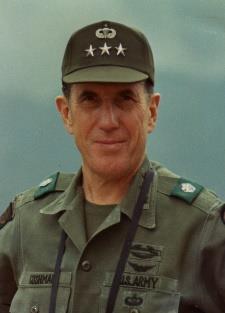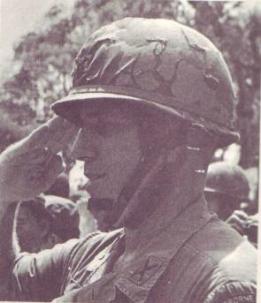
 |
|
JOHN H CUSHMAN 2nd BRIGADE COMMANDER |
 John H. Cushman - 2nd Brigade Commander, Vietnam 1967 - 1968 Major General Cushman would later became Division Commander - April 1972 - August 1973 |
On 1 September 1967 at Fort Campbell, Kentucky, I took command of the 2d Brigade, 101st Airborne Division. The division, commanded by Major General Olinto M. Barsanti, had been alerted for mid-December air movement to Vietnam, to join its 1st Brigade already there. In September we shipped out our non-deployables, took in their replacements and more, and organized a fourth rifle company in each battalion. Before departure, half the brigade at a time would take a two-week leave while the other half prepared for movement. That left but six weeks for unit training, squad to brigade. Twenty years later it was satisfying to read in Sergeant Charley Gadd's book, Line Doggie... "It was snowing lightly ... when our C-141 Starlifter ascended from the runway at Fort Campbell, Kentucky. We were a well trained group--A Company, 1st Battalion, 501st Infantry--an element of Uncle Sam's proud 101st Airborne Division... Most of us were replacements ... from every aspect of training that the Army had to offer--military police, armor, artillery, mechanics, clerks, cooks ... but three months of intense infantry training had honed us to the sharpness of expensive cutlery." We went first to Cu Chi in an enemy infested area near Saigon where a patrol could be fired on within minutes after leaving the base camp's gates. Before long we received orders to move far north, by air to the Hue-Phubai airfield where we would report to the 1st Air Cavalry Division; General Westmoreland suspected that something was up. The afternoon of January 30 we occupied fire bases north of Hue (the Cav called them LZs, for "landing zones"). That night the North Vietnamese launched their Tet Offensive. The next weeks saw the heaviest fighting, largely against North Vietnamese Army (NVA) battalions, of the Vietnam War. In Hue, in the paddies northward into Quang Tri province, and in nearby hills and forests, 2d Brigade battalions fought alongside local forces and the Vietnamese Army's 1st Infantry Division to drive out the enemy and bring security to the area. One day in early June 1968 I was in the office of Major General Ngo Quang Truong, 1st Division commander. He invited me to the Vietnamese Armed Forces Day ceremonies at his headquarters two weeks hence, saying "Bring your colors." He had arranged for the President of the Republic of Vietnam to present his country's Cross of Gallantry with Palm to the 2d Brigade. John H. Cushman Lieutenant General U.S. Army, Retired |
| 30 May 1968 Colonel John H. Cushman earned the Silver Star Medal while distinguishing himself on 30 May 1968 while serving as Brigade Commander, Second Brigade, 101st Airborne Division, on a combat operation with 2nd Squadron, 17th Cavalry in the village of Thon Le Xa Dong, Thua Thien Province, Republic of Vietnam. The Second Squadron, 17th Cavalry, which was under the operational control of the Second Brigade, made contact with an enemy force in the western end of the village. By noon it was evident that a strong enemy force was occupying the village. Colonel Cushman was over the battle area in a light observation helicopter, and sensing an opportunity to encircle and destroy the enemy force, he ordered a rifle company from a nearby battalion to be combat assaulted into a position north of the village. He then persuaded Army of the Republic of Vietnam authorities to order an infantry battalion to a cordon and blocking position west and northwest of the village. Despite hostile fire throughout the battle area, he remained aloft personally directing devastating air strikes and artillery fire, and on many occasions joined United States and Army of the Republic of Vietnam commanders on the ground to determine the situation, give them counsel, and arrange for their support. Disregarding the hazards of night flight in the light observation helicopter, Colonel Cushman stayed aloft for several hours after darkness, counseling his commanders, adjusting cordon positions, and insuring flare ship and artillery support. During the night the trapped enemy attempted in vain to break out of the ring of troops. The following morning the systematic destruction of the enemy force was completed. Included among the enemy losses were the command groups of a battalion and regiment. These losses coupled with the large number of enemy casualties and prisoners rendered the enemy battalion and its regimental headquarters ineffective as remnants of the force fled to the mountains. This action, which was the tenth in a series of successful cordon operations conducted by the brigade under Colonel Cushman, brought the total enemy losses in these ten operations to eight hundred and twenty killed and two hundred captured, with remarkably light casualties. Colonel Cushman’s heroism and devotion to duty were in keeping with the highest traditions of the military service and reflect great credit upon himself, his unit, and the United States Army. |
 |
| 27 April – 03 May 1968 2D BRIGADE/101ST TASK FORCE IN VIETNAM: With an encirclement featuring brigade actions in each of the two previous weeks, the 2d Brigade was getting a reputation. |
On 28 April The Quang Dien district chief remarked at a ceremony that, according to a recently captured NVA prisoner, his local enemy commander had told his unit that when they get in heavy contact with airborne troops they must make every effort to stop the advance of the airborne during the day and get out of the area during the night because the paratroopers will fight through the night and defeat them. And a message found on an NVA soldier killed in an ambush had said something like “if you make contact with the airborne, get out fast; they will surround you and kill you.” It was also at about this time that I passed by the interrogation of a captured enemy soldier whom I saw pointing at the Screaming Eagle patch on a nearby trooper. I asked the interpreter what the enemy soldier was saying. The reply was, ”He is saying that little bird is real mean.” So we built an archway over the steps leading down into our TOC and placed on it a sign, “That Little Bird Is Real Mean.” |
| April 28 - (Contd) Began the 2d Brigade’s classic cordon at Phuoc Yen. The 1st ARVN Division’s Black Panther Company, working with the 1/501, had received intense fire from an enemy force, possibly a battalion, at the north, or open, end of the “stocking” formed by the Song Bo River around that village. Brigade told the 1/501 to take advantage of the river to build a cordon around the trapped enemy, ordering that A/1/502 be inserted alongside the Black Panther Company to close the gap between its left flank and the Song Bo. The 1/501 moved its A Company overland to the Song Bo’ banks to the west of the village and brigade helli lifted B/2/501 into a position from which the 1/501 could place that company on the river’s bank south of the village. To cover the east bank of the Song Bo, brigade arranged for three PF platoons from Huong Tra district plus a platoon of Catholic militia from a nearby hamlet. An encirclement was in place. Night-long illumination was called. |
Before dawn on 29 April The enemy attempted three times to break through the A/1/502’s left flank, which was on the river bank. A Company stood firm and drove the enemy back. At 0800 that morning A Company attacked into the village but was itself driven back and the cordon continued that day and night. |
On 30 April B/1/501 replaced the Black Panther Company and that evening D/2/501 reinforced the cordon with one platoon alongside the hamlet militia at the river on the northeast corner of the encirclement and the rest of D Company reinforced A/1/502 and B/1/501 at the top of the cordon. That night the cordon was again sealed that under continuous illumination while the enemy was pounded with 105mm, 155mm, and 8 inch artillery fire. Again the enemy tried without success to find a gap in the troops’ line. |